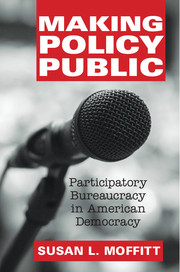Book contents
- Frontmatter
- Dedication
- Contents
- List of Figures
- List of Tables
- Preface
- Abbreviations
- 1 Portals of Democracy in American Bureaucracy
- 2 Participatory Bureaucracy in Practice
- 3 The Development of Public Committees
- 4 Making Educational Performance Public
- 5 Private Knowledge for Public Problems
- 6 Setting the Public Agenda
- 7 Deliberate Participation
- 8 The Impact of Public Advice
- 9 Participatory Bureaucracy in American Democracy
- Appendix
- Bibliography
- Index
- References
Preface
Published online by Cambridge University Press: 05 October 2014
- Frontmatter
- Dedication
- Contents
- List of Figures
- List of Tables
- Preface
- Abbreviations
- 1 Portals of Democracy in American Bureaucracy
- 2 Participatory Bureaucracy in Practice
- 3 The Development of Public Committees
- 4 Making Educational Performance Public
- 5 Private Knowledge for Public Problems
- 6 Setting the Public Agenda
- 7 Deliberate Participation
- 8 The Impact of Public Advice
- 9 Participatory Bureaucracy in American Democracy
- Appendix
- Bibliography
- Index
- References
Summary
“The Board helped me get my job done,” former Indiana Director of Medicaid Managed Care, Sharon Steadman, recalled, referring to the Drug Utilization Review (DUR) Board that advised her on prescription drug formularies for Indiana’s Medicaid Managed Care Organizations. Director Steadman perceived the public board, which consisted primarily of physicians and pharmacists, as a valuable way to give ideas “legs” and buffer formulary decisions from industry pressure arising from both managed care organizations and pharmaceutical firms. Conventional portraits of public bureaucracy emphasize private information, closure, control, and cozy relationships with industry; but Director Steadman’s account portrayed the board as offering independent information on formulary decisions. The disconnect between these two views of public bureaucracy caught my attention and launched my study of public committees well over a decade ago. I wanted to know when public bureaucrats would seek openness over secrecy and collaborative decision making over exclusive control, and why. I set out to understand public participation from the perspective of bureaucratic administration: when does participation through boards and committees help bureaucrats “get the job done,” and when does it not?
Since both secrecy and technical expertise represent hallmarks of bureaucratic administration, assessments of public participation through public committees typically focus on their potential to promote or inhibit democratic accountability through participatory oversight: to induce an otherwise closed bureaucracy to attend to nonbureaucratic voices in the policy-making process and to enable individuals to monitor agency decisions. When, however, can public participation support public bureaucracy, and when is participation not imposed on but initiated by bureaucrats? As I answer these questions, I develop the concept of participatory bureaucracy: a systematic process of public engagement that brings diverse expertise to bear on interdependent task implementations that exceed the scope of conventional bureaucratic hierarchy. When participation is bureaucratic, it advances competent policy implementation consistent with the core elements of bureaucratic reputation: unique agency expertise and diverse support. When bureaucracy is participatory, the scope of participation and policy decisions are fluid, not perfunctory means of rubber-stamping an agency decision or manipulating the masses.
Information
- Type
- Chapter
- Information
- Making Policy PublicParticipatory Bureaucracy in American Democracy, pp. xi - xviPublisher: Cambridge University PressPrint publication year: 2014
